
Good Game: Dun Dun Junnnnd
by Andrew Hanson
Alright, let me begin by apologizing for the title. If you haven't figured it out, it's a terrible play on that ominous three note diddy that gets played when some dark revelation happens in campy movies or cartoons. But I hope it made it clear as to what I'll be talking about today.
Jund. There are a lot of ways to build Jund. The deck that was huge just a month ago was more of a midrange deck that focused on its three-drops (as they were what a Bloodbraid Elf would cascade into), and would often curve all the way up to a spell with a 5 converted mana cost, most commonly Bituminous Blast, though some builds went with a creature instead like Demigod of Revenge. That form of Jund is still around, and is still good. But it's not the Jund I'll be looking into today. No, I'm going to look at a faster Jund. Let me introduce Jund Aggro:
| Jund Aggro, as suggested by Andrew HansonMagic OnlineOCTGN2ApprenticeBuy These Cards | ||
|---|---|---|
|
Land 4 Dragonskull Summit 3 Forest 2 Mountain 4 Rootbound Crag 4 Savage Lands 3 Swamp 4 Verdant Catacombs Creatures 4 Bloodbraid Elf 4 Great Sable Stag 4 Putrid Leech 4 Vampire Lacerator 4 Vampire Nighthawk | Spells 4 Burst Lightning 4 Jund Charm 4 Lightning Bolt 4 Maelstrom Pulse | Sideboard 3 Blightning 4 Deathmark 4 Magma Spray 4 Sprouting Thrinax |
The Deck

Hit 'em with some asphalt! What?
Also, this deck doesn't run Blightning in the main. Now, not all Jund builds do, but it's pretty popular. And the card has earned its stripes. So why not run it? It doesn't have an impact on the board. Yes, it is card advantage and damage all rolled into one card, but it doesn't do anything about what your opponent has on the board already. And, as this Standard seems to be very aggro- and creature-centered, I figured the maindeck has to be designed to fight those kinds of decks first. Blightning can be sick against control-ish decks, so it does get itself some sideboard space.
The presence of a one-drop, though not that common, can really make for explosive opening hands. It's hard to top a turn one Vampire Lacerator into a turn two Putrid Leech, especially if that leads into removal. But between the Lacerator, the Leech, and the Verdant Catacombs, this deck is looking at hurting itself a lot. That's why Vampire Nighthawk gets some deck space.
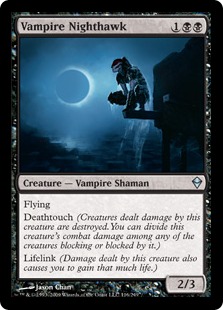
Offsets the Leech, Lacerator, and fetches.
This is an ability that hasn't been put on too many Standard-playable bodies, which is sad, as it's nutty. Vampire Nighthawk can hold back pretty much anything (other than a Baneslayer Angel, but who does that?), and that 3 toughness lets it block almost all one-drops with impunity and requires more than an unkicked Burst Lightning to kill. Sure, it's no Kitchen Finks, but what is?
The maindeck Great Sable Stags are a concession to not only Monoblack Vampires, but to other Jund decks as well. Putrid Leech is a monster, so having maindecked hate against it is good. And now that Faeries is gone, it's easy to forget how evil blue is, but that pro-blue is still useful. The Stag can block Rhox War Monks all day long, and swings right through Wall of Denials.
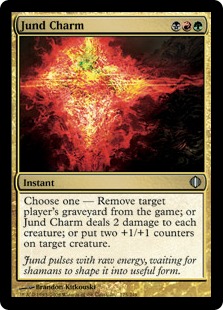
Weenie sweepers are still good.
Onto the sideboard. I've already mentioned Blightning's place there. It's great against any slower, control deck, and is generally useful enough to be swapped in for a rogue matchup. Deathmark is simply awesome. It kills Baneslayer Angels, the card half of Broodmate Dragon, Putrid Leeches, their turn one NobleHeirarch/Birds of Paradise/Llanowar Elves, and Knight of the Reliquary despite the bajillion lands in the opponent's yard. Both green and white are seeing a lot of play in this new Standard, whether it's Jund, Green/Black/White Rock, or Monowhite Soldiers, making this a solid sideboard inclusion.

Unearth this!
Sprouting Thrinax, I feel, is an interesting inclusion in a sideboard. Originally, he was in the maindeck, as he is the kind of card that belongs in a maindeck. But this was also when Jund Charm was not in the maindeck, and initial testing suggested that Jund Aggro needed some kind of board sweeper in its main. Thus, the Thrinax got the bump. Some may think the Stags should have gotten the bump, but it seems that, especially at the shop where I play, most decks have some element of black or blue in them.
But why keep him in the sideboard? Why not cut him entirely? Well, what if Great Sable Stag isn't that useful, but I don't want to cut creatures? The Thrinax is a good replacement. Decks in mind when I say this are Monowhite Soldiers, where the Thrinax can give you a token presence to fight with, and Monored, where the Thrinax is extra stalling. Also, against a deck in which Jund doesn't need to worry about its life total that much, like the new control decks sporting Day of Judgment, the Thrinax is a good board choice. If he comes down pre-Day, you still have a board presence after the sweep.
Performance
So how does this deck do? In a word: well. In my testing, it did great against Monowhite Soldiers, against Bant Aggro, and against a Black/Green/White Rock-style deck that featured Ob Nixilis, the Fallen. I didn't test it against Monoblack Vampires because I haven't built that yet (my bad). In my testing, there was only one deck it had problems with: Monored.
But my wife, Kari, ran this deck at the last Friday Night Magic. Round one, she went up against a Monored deck, but the match ended up being pretty luck-based. She won a close game one, but then game two she had to mull to five (she lost that one), and game three her opponent had to mull to four (she won that one).
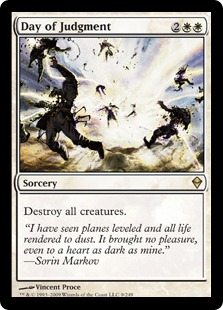
What kind of newb wouldn't run this in their
Bant Control-ish deck? Oh, wait...
Round three, she went up against a green/white fatties deck that also ran Day of Judgment. Typically, the deck would ramp into some mega 5-converted-mana-cost creature, like Baneslayer Angel or Ant Queen. Game one, she had to take out three different Ant Queens, but ran out of removal for the Thornling. Game two, Kari came out fast, had removal for her opponent's first few threats, and beat him down mercilessly when he hit a land pocket. Game three was simply a repeat of game two.
Round four, she went up against Monoblack Control. It wasn't Vampires, opting for some discard a la Duress and Mind Sludge, but it ran the same removal suite as the more aggressive deck. Well, plus some Consume Spirit. Its big finisher was a Nyxathid that is really good with Mind Sludge. Game one, Kari came out fast. Her opponent had some answers, though, but in the end, Kari had too much tempo and kept drawing gas. Game two, her opponent played a solid control game, removing her early threats, then jacking her hand with a Mind Sludge. Game three, Kari came out fast again, but this time her opponent didn't have a hand that could keep pace. She ended up wrecking him with a pair of Putrid Leeches and a Vampire Nighthawk pumped by a Jund Charm.
The one thing you can see from this is how Jund Aggro doesn't leave room for the opponent to stumble. If the opponent misses his removal, or hits even a small land pocket, it often sets them too far back to make any kind of come back. It tears apart the "fish" strategy of developing a board and then protecting it with counter magic as it develops a nastier board just as fast, if not faster, than the fish deck. It's hard to glean much from the Monored matchup, though, as that deck stumbled against Kari. When Monored stumbles, the matchup doesn't make too much of a difference - its chances to win go way down.
Kari also managed to make the Tuesday Night Magic our store hosts. In her first round, she went up against Monoblack Vampires. Game one, she saw twelve lands. In a deck that doesn't have any accelerated draw, that's pretty harsh. Game two, she came out strong with Putrid Leech into Vampire Nighthawk, and just demolished her opponent. Game three, she had a good hand with Putrid Leech, Nighthawk, removal, and the land to play it all. Her opponent kept a one-lander... and then drew three land off the top. Meanwhile, Kari drew land non-stop again.
Round two, she went up against Monowhite Soldiers. Game one, she traded cards initially, but hit a land pocket and rolled over to a Soldier and an Ajani Goldmane. Game two, she landed an early Nighthawk and went the distance with him, keeping her opponent's board clear the whole time. Conqueror's Pledge? Maestrom Pulse. Game three, she came out with a turn two Leech, and second Leech on three, then Blightning on turn four. Ouchy for her opponent.
Her third match was against Monored. Game one, Kari got blown out—Monored, with a good hand, is too fast pre-board. Game two, though, she had double Blightning. Against a deck that trades cards for life, Blightning almost says "gain 6 life." Game three, she burned the crap out of his early plays, then hit him with a crucial Blightning again, which put some unearth creatures in the bin. But she followed it up with a Jund Charm, exiling the yard. After that, her Sprouting Thrinax got there, trading with a Hellspark and still leaving her with 3 power worth of creatures.
Round four, she went up against a Bant Control deck. This one was an actual control deck, with Day of Judgment and everything. Game one, she came out strong, with a Putrid Leech on two, and another on three. But the Leech on three got countered, and her first Leech only hit once before getting Pathed on its next swing. Then the game went downhill for her. I dropped... I mean her opponent dropped a Rhox War Monk and followed it up with a Cudgel Troll, which is actually quite hard to deal with. The Troll eventually had a friend come down and the two went the distance on her.
Game two, she had to mull to four, though she still put up a good fight. Her opponent opened with a turn three Rhox War Monk and a turn four Monk. Kari hit her black source then, and Pulsed them both before her opponent could get counter mana open. But, she was still without much to do (four card starting hand and all) and was soon getting beat down by a pair of Cudgel Trolls and a River Boa. On her last turn, she Pulsed the Cudgel Trolls to use up her opponent's green mana on regeneration, then Pulsed them again to get them off the board. But it was really just to spite the Trolls—the River Boa was lethal.
Though Monored is supposed to be one of Jund's worst matchups, Kari is 2-0 against the deck so far. Her worst matchup actually seems to be control decks running card advantage and Day of Judgment. She can't reliably start her beats on turn two, and that loss of tempo really hurts. Also, regenerators seem to give her serious problems, which could require inclusion of some amount of Terminates. The other thing is that her deck seems to get land flooded quite a bit. Is 24 lands too many? I think we may knock a land or two out and see how it goes, but tell me what you think in the forums.
The True Sligh Deck
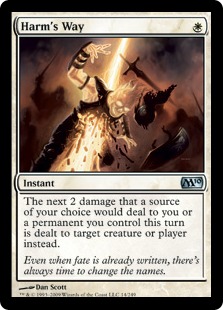
It's kinda like burn.
I liked this idea, so I made the change to the deck and ran it a bit. It worked really well...at first. But that was against another experimental deck that had some glaring issues. As we expanded the field, R/B/w Sligh's problems really became apparent.
First, its mana base. It wasn't too hard to get a red, black, and white source down by turn three, but that's not the problem. When you had all three sources down quickly, you had one of each. Do you know how much red mana a Sligh deck will want to use in a typical turn? In case you don't know, it's more than one of those little fireballs.
There's a reason Extended Zoo runs only one or two sources of mana that can't produce red mana. If you have a red creature, you don't want to have to choose between playing the creature or being able to play your removal. Even if you don't have a red creature, quite often, you want to be able to play two—and sometimes even three—burn spells in a single turn cycle.
So, when your land base is a Mountain, a Swamp, and a Plains, your style can, and does, get cramped.

This guy's got stamina.
So what was my deck's problem? It had Ranger of Eos in the main. Yes, but what did the Ranger fetch? In Extended, he gets a pair of 3/3s. In the last Standard season, he would usually fetch a pair of 1/1 Kithkin that would regularly turn into 4/4s, and sometimes 8/8 flying first strikers. Even in the Naya Aggro Standard decks of right now, they're fetching up those Wild Nacatls like an Extended deck. My deck? It would go and get a pair of 2/2s.
Don't get me wrong, an early 2/2 (especially on turn one) can be a beating. But that's usually because it has other cards being played around it for support. When you throw down that Ranger, it's in the midgame, and you usually need something to break a stalemate or, heaven forbid, make a comeback. A pair of 2/2s without any real abilities don't do that. The opponent's Putrid Leeches, Knight of the Reliquaries, or Woolly Thoctars tend to outclass your measly little 2/2s, even if they have haste.
So, my deck didn't work as well as I would have liked. But don't let that make you think I'm saying Sligh doesn't work in Standard. It just doesn't run three colors (at least, those three colors). It probably runs just two colors (and those would be red and white, with Steppe Lynx and Plated Geopede for unfair beats on the first few turns). But if I were to run any kind of Sligh deck at an event, it'd only run one color: red. And, boy, is it fast.
| Monored Sligh, as suggested by Andrew HansonMagic OnlineOCTGN2ApprenticeBuy These Cards | ||
|---|---|---|
|
Land 4 Arid Mesa 11 Mountain 4 Scalding Tarn 4 Teetering Peaks Creatures 4 Ball Lightning 4 Goblin Guide 4 Hell's Thunder 4 Hellspark Elemental 4 Jackal Familiar 4 Plated Geopede | Spells 4 Act of Treason 1 Banefire 4 Burst Lightning 4 Lightning Bolt | Sideboard 3 Earthquake 3 Goblin Ruinblaster 3 Magma Spray 3 Siege-Gang Commander 3 Volcanic Fallout |
This deck has speed and incredible reach. Even a turn one Jackal Familiar is a brutal start, especially if you're holding a Hellspark Elemental or a Goblin Guide in your opening hand. Plated Geopede is a sick two-drop if you have fetches to play behind him (or even Teetering Peaks), and the plethora of fetches in the deck are there to not only land-thin, but to help keep the Geopede a respectable, if not ridiculous, size.
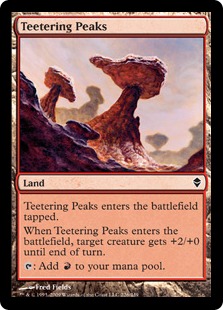
A land that effectively deals 2 damage?
Oh, you better believe it's red.
This deck can be very fast, and it happens to be one of the very few bad matchups for Jund Aggro. Because I'm working on something new, and I'm not really interested in running mono-red, I haven't really been playtesting this deck, just playtesting against it. So I'm not sure how it does against Monoblack Vampires (I imagine Tendrils of Corruption can give you fits), or against 5CC (yes, it's still here), but I know it hates Rhox War Monk with a passion, River Boa can be tough to deal with, and Deft Duelist downright destroys it.
What am I testing that I'm running Monored against Rhox War Monk and River Boa? I've put plenty of hints throughout the article. I mean, I practically said it. Okay, yeah, I'm working on a Bant Control deck running green regenerators. Next time, I'll show the decklist (after I work out most of the kinks) and tell you how I got there.
Comments